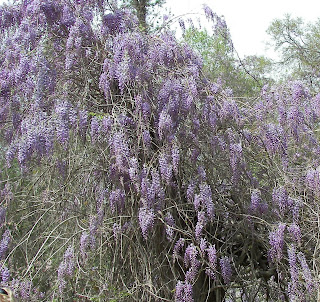




A spot between the Atlantic Ocean and the Amelia River....what could be better? Not much! This was a beautiful campground with lots and lots of hiking, biking trails and beaches.
There's even a fort here although no battles were every fought here. The funny thing is, our riverboat guide told us that the fort does a re-enactment battle there every year. She just has no idea what battle they're re-enacting! It was build pre and during the civil war as a general defense and never completed.
There seem to be three distinct areas to Amelia Island: one very weathly area with huge homes, condos, golf courses and resorts; one beach front area with a mix of very large nice homes to summer cottages; and one middle to lower middle class housing area.
Fernandina Beach (on Amelia Is) has a quaint downtown area that is a pleasure to walk and, in my case, window shop. There are many Southern style homes that I would have loved to have seen the inside. The Amelia Island lighthouse is also a sight to see. It's no longer operational and has been taken over by the city.
I mentioned our riverboat guide.....we took a trip up the river and over to Cumberland Island. This is where the wild horses abound.
Also, acccording to the internet, Dungeness on Cumberland Island, Georgia, is a ruined mansion that was the home of several families significant in American history. James Oglethorpe first built on Cumberland Island in 1736, building a hunting lodge that he named Dungeness. The next Dungeness was designed by Revolutionary War hero Nathaniel Greene, who had acquired 11,000 acres of island land in exchange for a bad debt. His widow built a four-story tabby mansion in 1803 on a Timucuan shell mound. During the War of 1812 the island was occupied by the British, who used the house as a headquarters. In 1818 Henry Lee III, known as Lighthorse Harry Lee and father of Robert E. Lee, stayed at the house until his death, and was buried there for a time. This house was abandoned during the U.S. Civil War and burned in 1866. In the 1880s the property was purchased by Thomas M. Carnegie, brother of Andrew Carnegie, who began to build a new mansion on the site. The 59-room Queen Anne style mansion and grounds were completed after Carnegie's death in 1886. His wife Lucy continued to live at Dungeness and built other estates for her children including, Greyfield for Margaret Carnegie, Plum Orchard for George Lauder Carnegie, and Stafford Plantation. By this time the Carnegies owned 90% of the island. The Carnegies moved out of Dungeness in 1925. In 1959 Dungeness was destroyed by fire, alleged to be arson. The ruins are today preserved by the National Park Service as part of Cumberland Island National Seashore. They were acquired by the Park Service in 1972.
The church (chapel) where John Kennedy Jr. and Caroline is also located on this island. We saw pictures of it and it's so small that many of the guests had to stand outside during the ceremony.......next to a rather large pig pen!






















